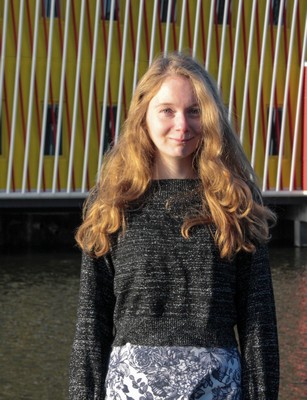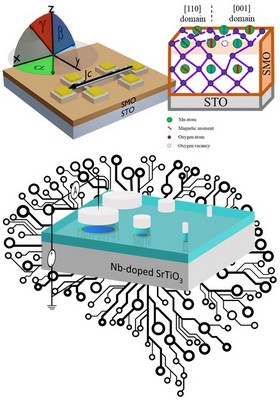Complexe oxiden maken de computers van de toekomst
De evolutie van de standaard microchips loopt op zijn einde, dus werken wetenschappers nu aan een revolutie. De grote uitdaging is om chips te ontwikkelen die minder energie gebruiken, en om hardware te maken waarin geheugen en rekenkracht gecombineerd zijn (in zogeheten memristors). Materiaalwetenschappers van de RUG beschrijven in twee publicaties hoe met complexe oxiden zeer energiezuinige ‘magneto-elektrische spin-baan’ (MESO) schakelingen zijn te maken, en hoe ze zijn te verkleinen.
De klassieke, op silicium gebaseerde microchips zijn uitontwikkeld. Om nog kleinere schakelingen te maken en het energieverbruik terug te dringen zijn nieuwe materialen nodig, en een nieuwe computerarchitectuur. Tamalika Banerjee, hoogleraar Spintronica van Functionele materialen in het Zernike Institute for Advanced Materials van de RUG onderzoekt verschillende kwantummaterialen die hiervoor te gebruiken zijn. ‘Onze benadering is om de materialen en hun grensvlakken te bestuderen, maar altijd gericht op praktische toepassingen, zoals geheugen of de combinatie van rekenkracht en geheugen.’

Zuiniger
Haar onderzoeksgroep liet eerder zien dat met strontium gedoteerd titaanzout is te gebruiken om zulke memristors te maken. De onderzoekers hebben onlangs twee artikelen gepubliceerd over schakelingen die de opvolgers kunnen worden van de bouwstenen van de hedendaagse computerchips, de CMOS schakelingen van standaard halfgeleiders,.
Eén kandidaat om CMOS te vervangen is de magneto-elektrische spin-baan’ (MESO) schakeling, die tien tot dertig keer zuiniger is. Verschillende materialen om die MESO’s te maken zijn al onderzocht. Job van Rijn, promovendus in de groep van Banarjee, is eerst auteur van een artikel in Physical Review B dat afgelopen december verscheen. Daarin staat hoe strontium manganaat (SrMnO3 of kortweg SMO) een goede kandidaat is voor het maken van MESO schakelingen. ‘Het is een multiferroïsch materiaal dat spintronica combineert met op elektrische lading gebaseerde effecten’, legt hij uit. Spintronica is gebaseerd op de spin van elektronen, een magnetische eigenschap.
Banerjee: ‘De magnetische en elektrische ordening is in dit materiaal gekoppeld, zodat we magnetisme kunnen schakelen met een elektrisch veld en polarisatie met een magnetisch veld.’ En niet onbelangrijk voor toepassingen, deze effecten zijn bij kamertemperatuur aanwezig. Van Rijn onderzoekt de sterke koppeling tussen de twee verschillende effecten. ‘We weten dat ferromagnetisme en ferroelektriciteit zijn af te stellen via mechanische spanning op het materiaal. Die krijgen we door dunne SMO films te laten groeien op verschillende ondergronden’, vertelt hij.

Spanning
Het onderzoek van Van Rijn laat zien hoe mechanische spanning ferroelektriciteit opwekt in het materiaal, en hoe het de magnetische orde beïnvloedt. Hij analyseerde de domeinen in de dunne films en zag dat magnetische interacties sterk afhangen van de kristalstructuur, in het bijzonder plekken waar zuurstofatomen ontbreken. Dit verandert de voorkeursrichting van het magnetisme. Van Rijn: ‘Uit experimenten met spintransport concluderen wij dat magnetische domeinen een actieve rol spelen in schakelingen die we maken van dit materiaal. Daarom is ons werk een eerste stap die kan leiden tot het gebruik van strontium-manganaat in nieuwe computersystemen.’
Op 14 februari publiceerde de groep van Banerjee een tweede artikel over schakelingen die CMOS systemen kunnen vervangen, in het tijdschrift Advanced Electronic Materials. Promovenda Anouk Goossens is de eerste auteur van dit artikel dat gaat over het verkleinen van memristors, gebaseerd op niobium-gedoteerd strontium titanaat (SrTiO3, kortweg STO). ‘Het aantal schakeling per oppervlakte-eenheid is belangrijk’, zegt Goossens. ‘Maar sommige typen memristors zijn moeilijk te verkleinen.’
Goossens liet eerder al zien dat het mogelijk is om schakelingen die logische bewerkingen en geheugen combineren te maken van STO. Haar nieuwe artikel laat zien dat het mogelijk is ze te verkleinen. Het is een algemeen probleem bij memristors dat ze slechter gaan functioneren als ze kleiner zijn uitgevoerd. Verrassend genoeg bleek dat kleinere STO memristors juist beter werken: ze krijgen dan een groter verschil tussen de toestanden met hoge en lage weerstand. ‘We hebben dit materiaal onderzocht met een elektronenmicroscoop, en zagen dat er veel lege zuurstofplekken aanwezig zijn op de grens tussen de schakeling en de elektrode’, vertelt Goossens. ‘Nadat we er een elektrische spanning op zetten, zagen we die legen plekken verschuiven, en dat is belangrijk voor de weerstand van het materiaal.’

Nieuw ontwerp
Haar conclusie is dat het verbeterde functioneren bij verkleining het gevolg is van een ‘rand-effect’, dat voor gewoon geheugenmateriaal juist negatief is. Maar in STO neemt het elektrisch veld aan de randen dan toe, en dat versterkt de werking als memristor. ‘In ons geval is de rand feitelijk de memristor’, zegt Goossens. ‘Daarnaast hangen de eigenschappen af van de hoeveelheid niobium die we toevoegen aan het materiaal. Daarmee kunnen we het materiaal afstemmen voor specifieke doelen.’
Deze twee publicaties laten allebei zien hoe een nieuwe computer architectuur is te maken. En de STO memristors van Goossens en Banerjee zijn al gebruikt door RUG-collega’s van het Bernoulli Instituut voor Wiskunde, Computerwetenscahp en Kunstmatige Intelligentie, en Cognigron (Groningen Cognitive Systems and Materials Center). Zij hebben daarmee een nieuw ontwerp gemaakt voor geheugenarchitectuur.
‘Dat is ook het doel van ons onderzoek’, zegt Banerjee. ‘We willen de natuurkunde van onze materialen begrijpen, en de manier waarop schakelingen daarvan werken, om zo toepassingen te maken.’ Goossens: ‘We hebben al een aantal toepassingen bedacht, we werken nu aan een random-nummer generator die werkt zonder algoritme en daarom niet te voorspellen is.’
Publicatie 1: J. van Rijn, D. Wang, B. Sanyal, and T. Banerjee: Strain-driven antiferromagnetic exchange interactions in SrMnO3 probed by phase-shifted spin Hall magnetoresistance. Physical Review. B: Condensed Matter and Materials Physics, 15 December 2022
Publicatie 2: A. S. Goossens, M. Ahmadi, D. Gupta, I. Bhaduri, B.J. Kooi, and T. Banerjee (2023) Memristive memory enhancement by device miniaturization for neuromorphic computing. Advanced Electronic Materials, 14 February 2023.
Meer nieuws
-
02 december 2025
Student Menna Zahran wint Unilever Research Prize
-
27 november 2025
Vliegtuigen spotten met een radiotelescoop

